Ask a question from expert
Managing Human Resources (PDF)
21 Pages5680 Words357 Views
Added on 2021-05-03
Managing Human Resources (PDF)
Added on 2021-05-03
BookmarkShareRelated Documents
OFFICIALMANAGING THE HUMAN RESOURCEMANAGING THE HUMANRESOURCEAssessment STUDENT NAME - COURSE - MBA MANAGEMENT CONSULTANCY UNIVERSITY OF WALESSTUDENT NUMBER - WORD COUNT - 43661
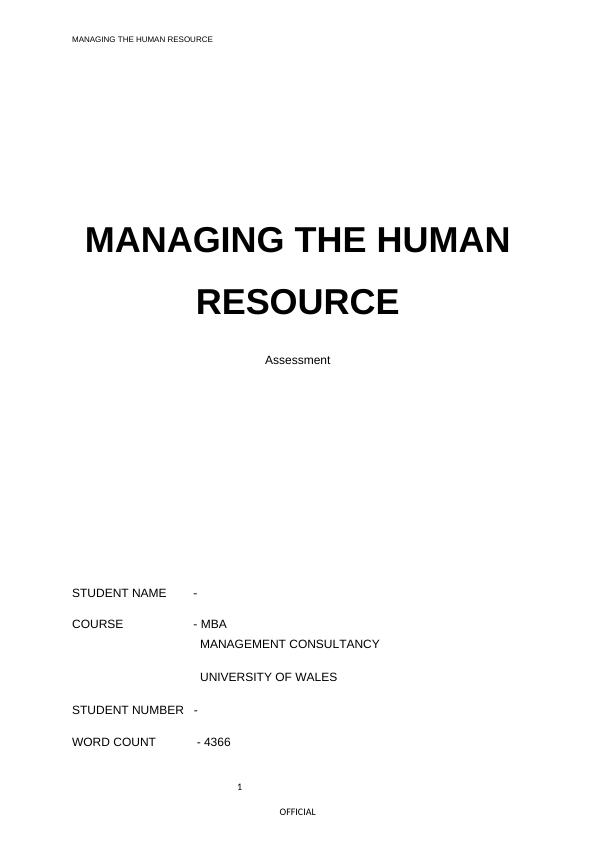
OFFICIALMANAGING THE HUMAN RESOURCEINDEX 1.1High Commitment Human Recourse Management.............................................31.2Abraham Maslow’s Hierarchy of needs..........................................................4 1.3Herzberg two factors theory.........................................................................6 2.1Internal labour markets and job Security.........................................................82.2Recruitment process; hiring, selection of right candidates..................................92.3A learning culture through continuous Training and development........................112.4Active employee involvement.......................................................................122.5Team working and self-management..............................................................132.6Reasonable pay and performance based rewards............................................142.7Reduction of status differentials/harmonisation...............................................153.1 Best Fit....................................................................................................153.2 Effective HRM Planning and advantages of Committed HRM Strategic Implementation.............................................................................173.3 Recommendations for a successful High Commitment HRM..............................18Bibliography....................................................................................................20AbbreviationHRM............Human Resource Management HR...............Human Resource2
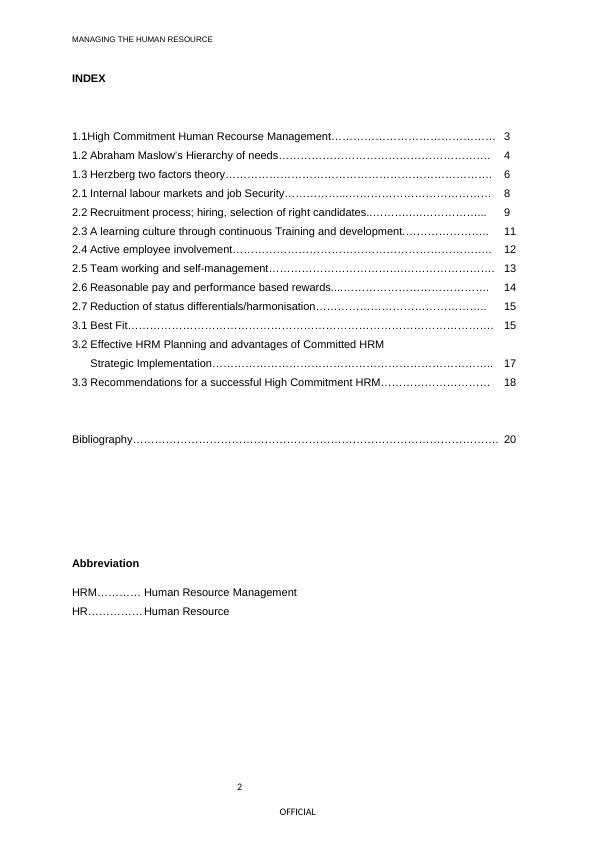
OFFICIALMANAGING THE HUMAN RESOURCE1.1High Commitment Human Recourse ManagementComparing to other established academic subjects such as politics, economics, law... etc,human resource management (HRM) is relatively a new area of study. In the past HRM ismostly associated with personnel management and industrial relations. There are severaldefinitions and developments in HRM in the past and is identified as one of the key featuresof a sustainable business entity. Generally HRM is “a philosophy of people management based on the belief that humanresources are uniquely important to sustained business success. An organisation gainscompetitive advantage by using its people effectively, drawing on their expertise andingenuity to meet clearly defined objectives. HRM is aimed at recruiting capable, flexible andcommitted people, managing and rewarding their performance and developing keycompetencies” (Price, 2004, p.35). Selznick (1957) highlights Organisational possession of idiosyncratic competence tooutperform competitors, further supported by Penrose (1959) categorising physical andhuman resources as the ‘collection of productive resources’. HRM is an important strategicelement, which drive core competencies to deliver advantages to the organisation. Barney(1991) used a SWOT analysis to stress the advantages of internal strengths and to reducethe effect of internal weaknesses. Ideally there are 4 dominant types of HR strategies depending on locus of control and ‘makeor buy aspect.’ (Bamberger and Meshoulam, 2000)A high commitment HR strategy compromise withInternal staff development, high investment in training3
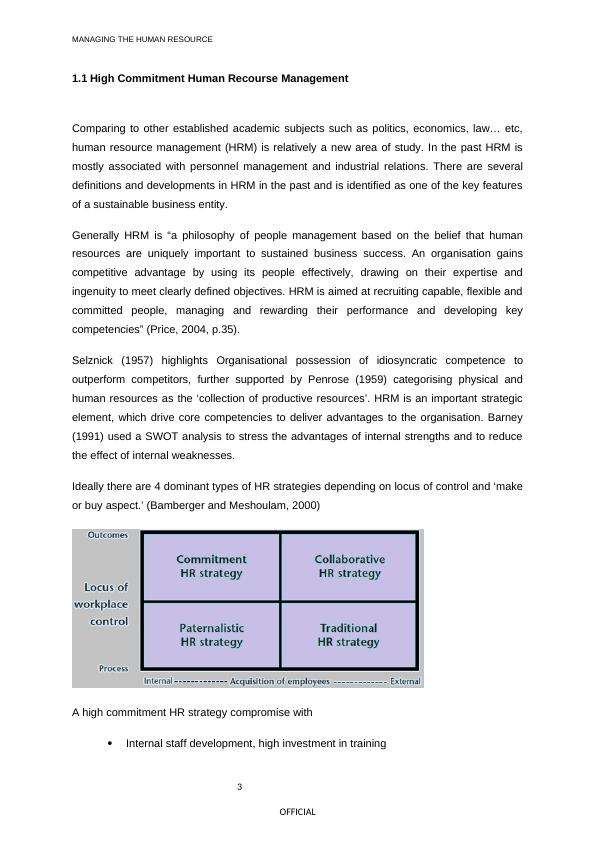
OFFICIALMANAGING THE HUMAN RESOURCELess compliance with process based standards, develop psychological contractwith mutual respect, trust focusing on outcomes.High commitment HRM practices are “commitment oriented HRM practices not onlyencourage employees’ motivation and willingness to contribute but also help forge a strongerpsychological connection between employees and organisations” (Arthur, 1994, p.677)1.2 Abraham Maslow’s Hierarchy of needs Human motivation and moral behaviour consist of five universal needs. It is necessary tofulfil Bottom level needs prior moving to top levels. This theory illustrates relationshipbetween motivation and moral against performance. Less motivation and moral impact staffdissatisfaction leading to employees leaving the business resulting high employee turnover.Less staff turnover at Starbucks, comparing to the retail industry implies fulfilment of staffneeds and High committed HRM.www.forrester.comMotivation is important to achieve organisational goals. “The desire to achieve beyondexpectations, being driven by internal rather than external factors, and to be involved incontinues striving for improvement” (Torrington et al., 2002, p.335).4
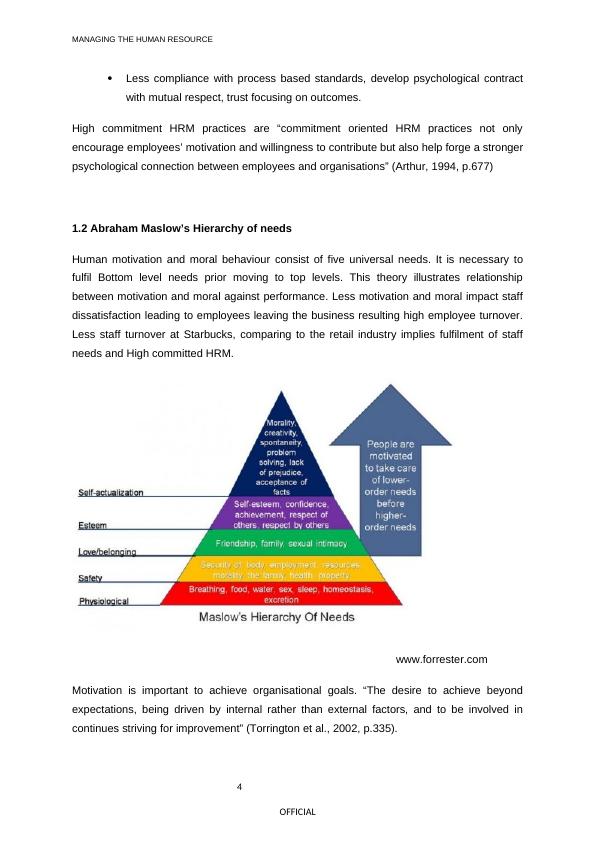
OFFICIALMANAGING THE HUMAN RESOURCEMorris (1981) defined morale as the individuals’ (groups) spirit and willingness to performassigned tasks. High morale of Starbucks staff positively associates with productivity, stateof mind, efficiency, psychological condition, performance and effectiveness. Despite limitations, Maslow attempted listing human needs in a systematic order. Suchattempts have been a key to the development of High Commitment HRM. According toMaslow's, achieving satisfaction is fulfilling needs. Maslow’s theory reflects,1.How needs group associate with different levels. Maslow underpins existence ofa standardised way in which these needs group and common solutions areavailable. Author argues employee’s motivation, morale and attitudes areinfluenced by external factors and depend on personal circumstance. Another factor is individuals’ attitudes towards work and how high level of needscan be satisfied through work. This is common in organisations practicingTraditional HRM and adopts a ‘one-size-fits-all’ approach. 2.What is the most important level of need and its distinction between other levelsof needs? A solution through such ambiguous prediction is not possible.3.A universal theory. Needs hierarchy fails to differentiate needs of individuals anddifferent cultures.In high committed HRM employees require flexibility of choosing their own bespoke bundleof benefits. Starbucks unique ‘your special blend’ compensation package is an example ofHigh committed HRM providing staff to decide what set of benefits they need. Employee motivators are the needs on higher levels at Maslow’s hierarchy. They consist ofrecognition, opportunities, responsibility and certain job specific factors which decide neitherthe satisfaction nor the dissatisfaction for growth towards self-actualisation. Starbucks provides low and middle level needs; by restricting existence of a staff Union,implies restrictions to self-actualisation and social equality as part of High CommitmentHRM.5
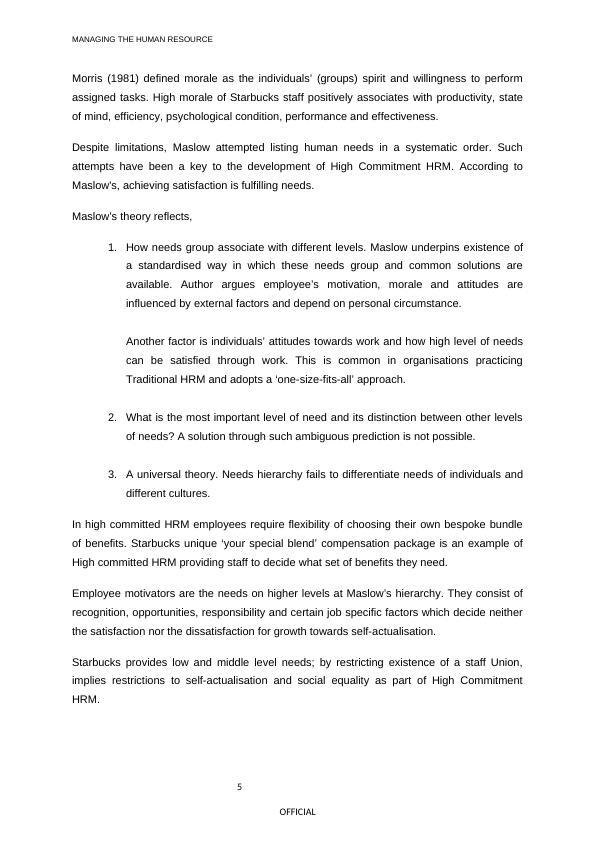
OFFICIALMANAGING THE HUMAN RESOURCE1.3 Herzberg two factors theory Frederick Herzberg argued there are two factors influencing motivation; Hygiene factors andMotivator factors. Herzberg’s theory does not directly debate motivation or morale; theorydiscusses job satisfaction at work providing the right working environment. From acontemporary view, Motivator-Hygiene theory is based on factors contributing employees’behaviour at work. Hygiene factors prevent dissatisfaction and pain. Example - workingconditions, company policies, administration and interpersonal relationships. Author’sargument is that existences of such factors provide limited motivation. Herzberg two factors theory (www.wordpress.com)Bowen (1980) identified recognition, achievement, work-life balance, possibility of growth,advancement, salary, policy and administration, interpersonal relations, supervision,responsibility, working conditions and the work itself as motivator-hygiene factors. Starbucks has created a great place to work environment even providing informal socialnetworking within the organisation using schemes such as ‘partner connection’, on-sitefitness programmes, ‘the wonderful world of food’ and ‘the new parent network’.Importantly the flexible work schedules enable employees a greater degree of work-lifebalance. Enhanced health treatment schemes are motivators for employees to retain in theorganisation. Author argues about the work flexibility at Starbucks. Starbucks provide parttime working opportunities. Comparatively to which extend Starbucks is actually flexible?Flexible work categorically differ from part time working to flexitime, home-working, term-timeworking, structured time off in lieu, compressed hours, annualised hours, job share andstaggered hours.(www.direct.gov.uk).6
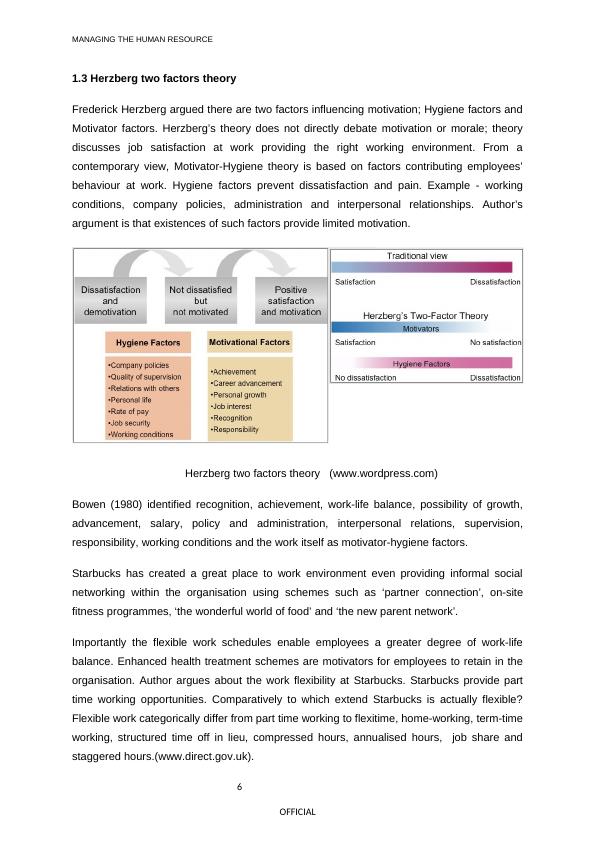
End of preview
Want to access all the pages? Upload your documents or become a member.
Related Documents
Introduction to the Business Studieslg...
|8
|1593
|396
Theories and Concepts of Motivation and Organizational Control and Reward Systemslg...
|20
|7408
|32
iHis Company and its Employeeslg...
|23
|8054
|262
Motivation Techniques of Jacklg...
|8
|1436
|42
Strategic Human Resource Management - Essaylg...
|7
|1766
|58
HR and Financial Managementlg...
|7
|2881
|76